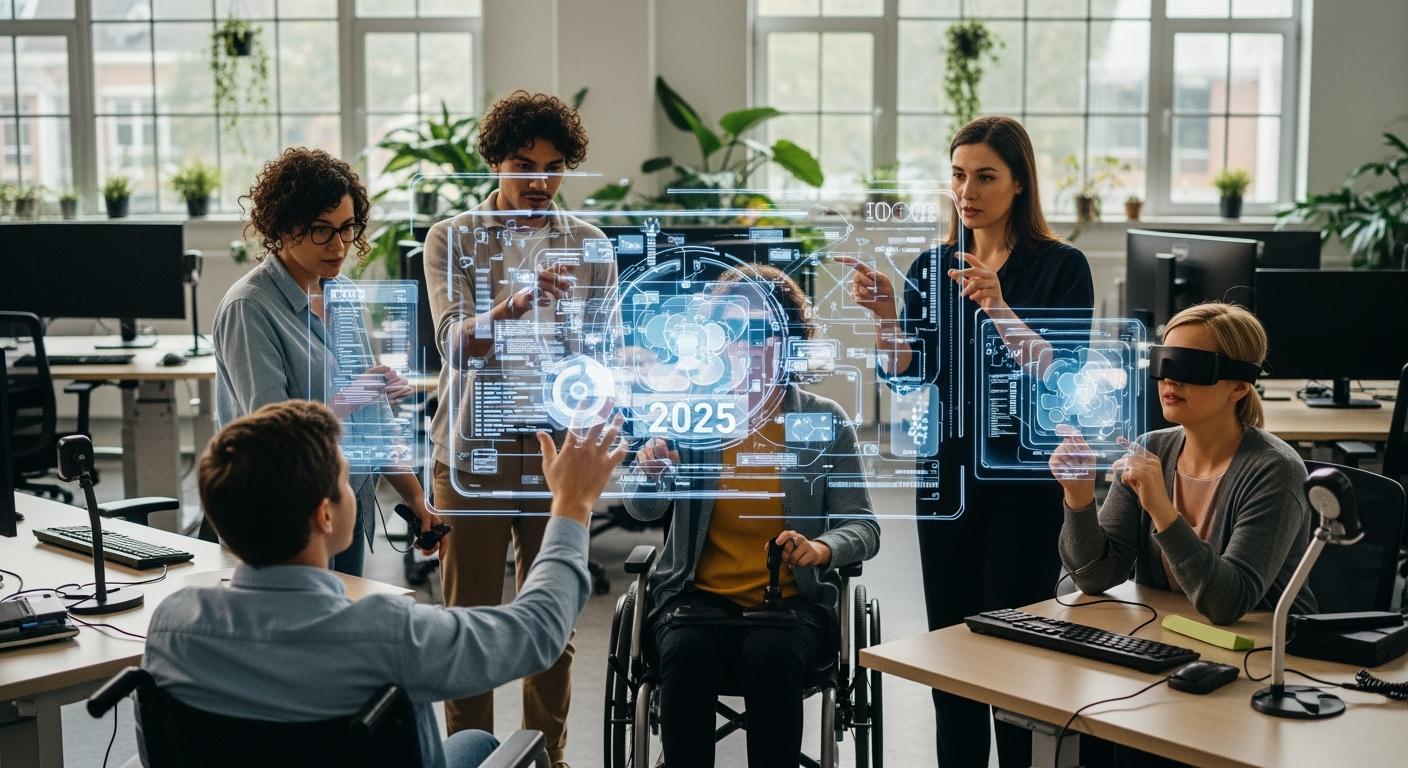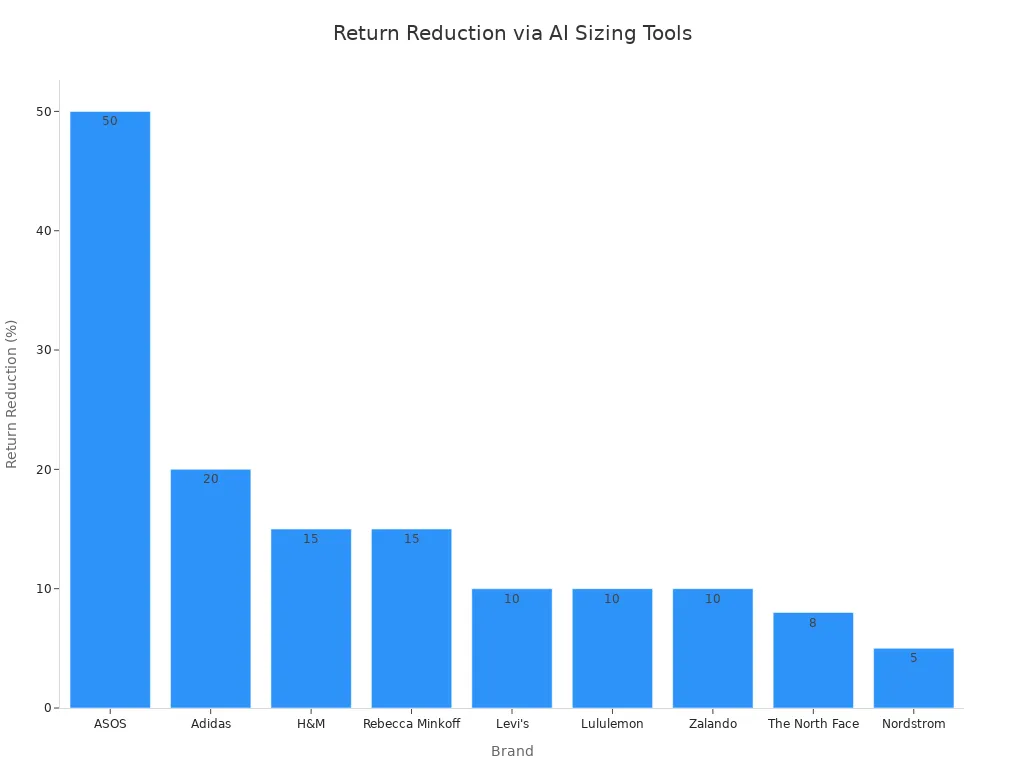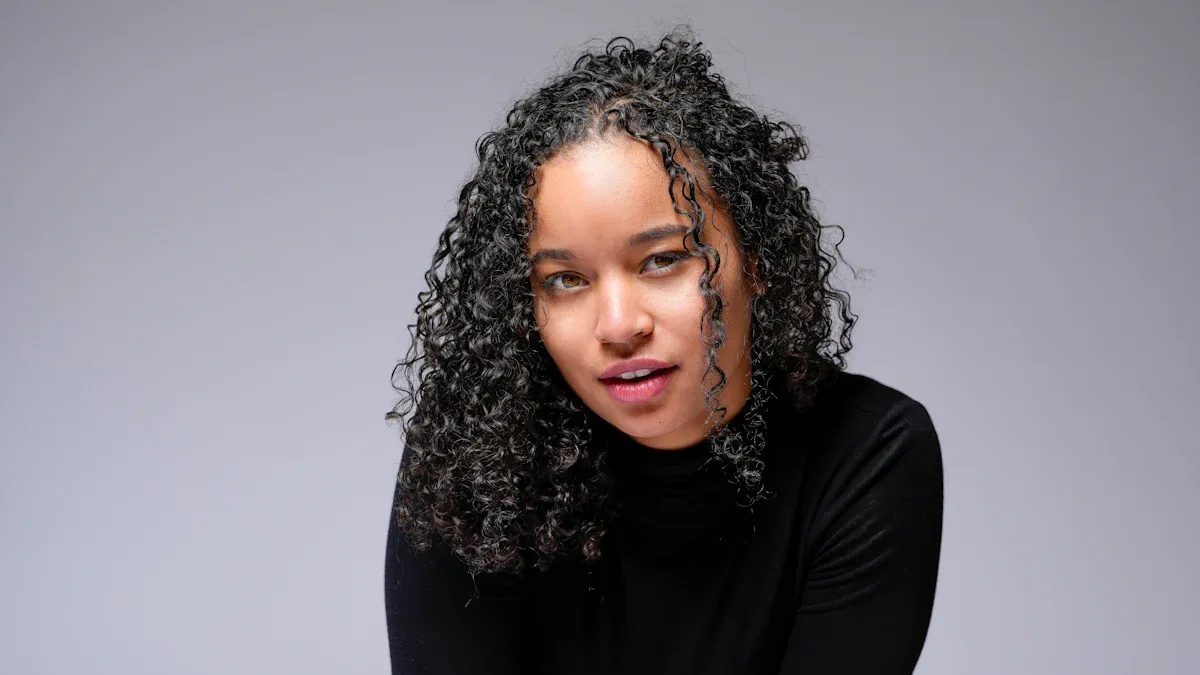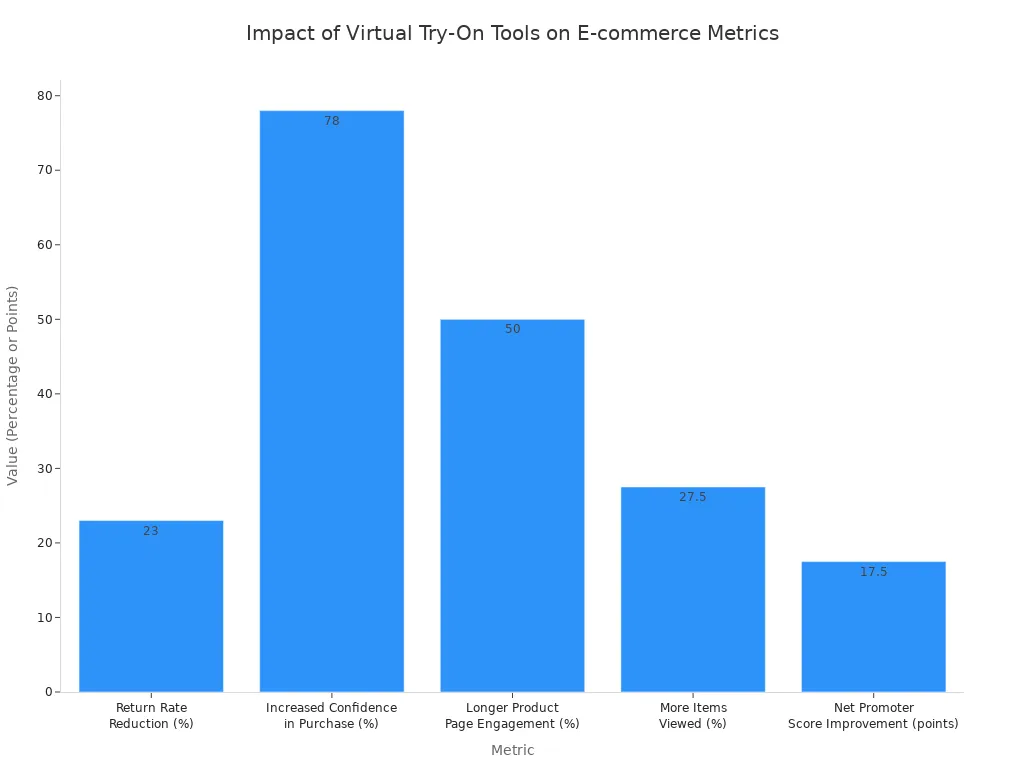
Artificial intelligence (AI) is transforming fashion. AI tools enable the design of truly inclusive fashion. This AI-powered fashion revolution meets a growing market demand. The global AI in fashion market is set to reach $3.14 billion in 2025, powering a new era of inclusive fashion. AI achieves this by analyzing diverse body data for better clothing fit and generating unbiased fashion design concepts. This process supports personalization and gender inclusivity. The future of inclusive fashion is here.
AI makes personalized shopping and personalized recommendations possible, creating an inclusive experience. This focus on diversity and designing inclusive fashion is reshaping the industry. The goal is fashion for all genders. This inclusive design approach is critical. AI helps create personalized, inclusive fashion.
Note: Consumer interest in inclusive fashion is surging.
- Between 50% and 70% of Gen Z shoppers show interest in gender-fluid dressing.
- Approximately 36% of U.S. consumers purchase clothing outside their traditional gender category.
AI provides personalized recommendations for a better shopping journey. The AI design process champions diversity and inclusivity. This personalized, inclusive fashion reflects a major cultural shift.
AI-Driven Sizing and Fit
Traditional fashion sizing presents significant challenges for inclusive fashion. Brands often face high return rates and customer frustration. This happens for several key reasons:
- Reliance on Fit Models: Garments are designed for an 'ideal' body shape that does not reflect most customers.
- Inadequate Representation: Standard sizes fail to account for the wide variations in real body types.
AI offers a powerful solution. AI modeling tools process vast datasets, including 3D body scans, to create sizing systems not based on outdated gender models. This approach is central to modern, inclusive fashion design. The AI analyzes data to understand fit for a diverse population, making fashion more accessible.
Spotlight on Sizing AI Tools
Advanced AI modeling tools are changing how brands approach clothing fit. These digital tools use a simple, effective process. A customer uses a smartphone to take two photos. The AI then gets to work.
- AI-Powered Analysis: The AI uses computer vision to identify the body's shape, even with clothing on.
- 3D Model Creation: It generates a complete three-dimensional digital body model from the 2D photos.
- Comprehensive Measurements: The system calculates dozens of precise body measurements in under a minute.
Leading AI tools like Mirrorsize provide this technology to brands of all sizes. It creates hyper-accurate, personalized measurements and integrates with major e-commerce platforms. The impact of these AI modeling tools is clear. Brands using AI-driven sizing see major reductions in returns, boosting both profit and sustainability. This makes for a better, more inclusive fashion experience.

Creating a Universal Fit Block
The data gathered by AI modeling tools has a practical application in fashion design. It enables the creation of a universal fit block. A fit block, or sloper, is a foundational pattern. It is a basic design that serves as a template for other clothing styles.
AI analyzes thousands of diverse digital body scans. This data helps designers create a foundational, gender-neutral pattern. This universal block ensures a better fit for all body types, moving beyond the limits of traditional gender categories. This inclusive design is the starting point for creating truly adaptive and personalized clothing. It improves body representation in fashion. This focus on size inclusivity and better representation is key for the future of inclusive fashion. The AI-driven process creates a more adaptive and personalized fashion future. This inclusive approach is essential for adaptive fashion.
Generative AI in Fashion Design

Beyond sizing, generative AI is a creative partner in modern fashion design. These AI tools help designers imagine novel silhouettes and patterns. This process moves fashion away from ingrained gender stereotypes. The AI generates new concepts, supporting a more inclusive and personalized design workflow. This approach is fundamental to creating truly inclusive fashion. The collaboration between human creativity and AI power is reshaping the future of fashion.
Co-Creating with Generative AI
Designers co-create with generative AI modeling tools to produce innovative concepts. Using platforms like Midjourney, DALL·E, and Adobe Firefly, they can turn simple text prompts into photorealistic digital fashion renderings. This digital process accelerates fashion design. It allows for rapid experimentation with new ideas. Several brands already use these AI modeling tools for inclusive fashion.
- Adidas uses AI to generate new colorways and patterns for its footwear.
- Stitch Fix employs AI modeling tools to create unique prints for its clothing lines.
- Maison Meta showcased a fully AI-generated collection at AI Fashion Week, turning text prompts into print-ready digital clothing.
This partnership between designers and AI makes the creation of personalized and inclusive fashion more efficient. The AI modeling tools provide endless inspiration.
Developing Gender-Fluid Aesthetics
Generative AI modeling tools are essential for developing gender-fluid aesthetics and non-binary fashion. To achieve this, the AI must learn from diverse and abstract data. This training method teaches the AI to avoid gender bias. It helps the AI create a more inclusive visual language. Human designers guide the AI, ensuring the outputs are creative and unique. This focus on diversity and inclusivity is key for the future of fashion.
An oversized fit is a top trend in gender-fluid fashion. This aesthetic avoids traditional gender categories for colors, prints, and fabrics.
Designers can prompt the AI to create inclusive clothing that reflects this aesthetic. For example, a designer might use a prompt for their AI modeling tools like:
asymmetrical tunic in sustainable linen, fluid drape, minimalist, gender-neutral
This command directs the AI to produce a design that is inherently inclusive. The result is a more personalized and diverse fashion landscape, where AI helps make inclusive fashion the standard.
Virtual Models and Inclusive Fashion

AI is also changing the customer-facing side of fashion. Virtual models and augmented reality (AR) are creating a more interactive and inclusive shopping journey. These AI tools help customers visualize clothing on their own bodies. This technology builds confidence and improves the entire digital shopping experience. The result is a more personalized and adaptive approach to online fashion.
AI-Powered Virtual Try-On
AI-powered virtual try-on technology is transforming online shopping. This technology uses a smartphone's camera to create a realistic preview. It works through a simple process.
- Computer Vision maps the user's body.
- Augmented Reality overlays the digital clothing onto the user's image.
- AI Algorithms adjust the fit and drape for a realistic look.
This process gives customers personalized recommendations and a clear view of how a garment will look. This form of personalization boosts shopper confidence. It also significantly reduces product returns, a major issue in the fashion industry. Better recommendations from AI modeling tools lead to a more satisfying and adaptive shopping experience. This makes for more inclusive fashion.

Promoting Inclusivity with AI Avatars
Beyond individual try-ons, AI modeling tools help brands create a more inclusive e-commerce presence. Platforms like Botika enable brands to generate digital fashion models. These AI avatars showcase a wide spectrum of body types, ages, and ethnicities. This approach to digital fashion promotes better body representation.
Brands using AI-generated models can create inclusive campaigns that reflect a wide range of body types, ethnicities, and genders. This promotes a more realistic and relatable image of beauty.
This use of AI modeling tools has a powerful impact. When customers see models who look like them, it fosters a sense of belonging. This inclusive representation makes a brand seem more relatable and socially responsible. For example, Levi's uses AI-generated models to supplement its human models, showing its clothing on more diverse digital bodies. This commitment to diversity and inclusive design is key for modern fashion. AI modeling tools make it easier for brands to create adaptive and personalized digital fashion. This is the future of inclusive fashion, where AI helps ensure everyone feels seen. The AI-driven design process supports inclusive fashion and better recommendations for all genders. This focus on inclusivity and diversity is essential for the future of fashion.
Predictive AI and Future Fashion Trends
Predictive AI is reshaping the future of fashion. It moves beyond simple sales data. This powerful AI analyzes digital trends to forecast what consumers will want next. This process helps brands create more relevant and inclusive fashion. The AI provides personalized recommendations for future collections. This makes the entire fashion design process smarter and more responsive to the market. The future of personalized shopping and fashion is here.
Forecasting Gender-Neutral Styles
Predictive AI excels at forecasting gender-neutral styles. The AI identifies emerging trends by analyzing massive amounts of digital data. This includes social media posts, search queries, and online shopping behaviors. The AI uses several techniques for this analysis.
- Social Listening: The AI tracks hashtags and influencer content to find micro-trends.
- Image Recognition: It analyzes images from social media to identify popular silhouettes and colors.
- Sentiment Analysis: The AI reads customer reviews to understand what people like or dislike.
This analysis helps brands understand the growing demand for inclusive fashion. For example, AI has identified oversized fits and utility clothing as key trends. These styles appeal to a wide audience regardless of gender. This makes the shopping experience more inclusive. However, brands must use this AI responsibly.
The integration of AI in fashion raises ethical challenges. AI models can reinforce gender stereotypes if trained on biased data. Brands must prioritize transparency, accountability, and consumer consent for responsible AI integration. This ensures the recommendations are truly inclusive.
This ethical approach is vital for building trust and creating a truly personalized and inclusive fashion landscape. The AI offers better recommendations for a better shopping journey.
Identifying Demand for Adaptive Features
Predictive AI also identifies the growing demand for adaptive features in clothing. Adaptive fashion includes design elements that make dressing easier for people with disabilities. These features make fashion more accessible and inclusive. The AI analyzes customer feedback, online searches, and social media conversations. This helps brands discover specific needs within the adaptive market. This process makes fashion design more personalized.
AI can pinpoint demand for specific adaptive solutions. These adaptive features include:
- Easy Closures: Magnetic buttons and large zipper pulls help people with limited dexterity.
- Sensory-Friendly Fabrics: Soft, tagless materials offer comfort for those with sensory sensitivities.
- Wheelchair-Friendly Fit: A higher back rise and longer front provide better coverage for seated wearers.
By identifying these needs, AI helps brands create truly adaptive and personalized products. This focus on inclusive design makes fashion better for everyone. The digital tools provide recommendations for a more adaptive shopping experience. This makes digital fashion more inclusive.
AI tools are transforming inclusive fashion. Brands use data analysis for an inclusive fit. Generative AI creates unbiased fashion design. Virtual try-on technology offers a personalized experience. This approach to fashion is very inclusive. Integrating these AI tools is a practical strategy for 2025. It helps brands design successful, inclusive fashion collections. This personalized fashion meets market needs.
AI's role in creating accessible interfaces, like Microsoft's Seeing AI, shows its potential for broader inclusivity.
In fashion, AI is becoming an essential partner. It makes personalized and inclusive fashion design the industry standard. The future of fashion is personalized and inclusive fashion. This focus on personalization creates a better future for inclusive fashion. This inclusive fashion is personalized.
FAQ
How does AI help with fashion sizing?
AI analyzes thousands of body scans. It creates sizing systems not based on gender. This process helps brands design clothing for many different body types. The result is a better fit for more people, making fashion more inclusive.
Can AI be biased in fashion design?
Yes, AI can show bias. An AI model trained on non-diverse data may create stereotypical designs. Brands must use varied datasets to prevent this. This ensures the AI supports truly inclusive fashion.
Are AI fashion tools only for big brands?
No, AI tools are available for brands of all sizes. Many companies offer AI services on a subscription basis. This makes advanced technology accessible to smaller businesses. It helps them compete in the modern fashion industry.
What is the main benefit of virtual try-on?
Virtual try-on technology boosts customer confidence. It allows shoppers to see how clothes will look on their specific body shape before buying. This feature reduces returns and creates a more personalized shopping experience.
See Also
Predicting Future Demand: AI and Data-Driven Insights for 2025
Revolutionary AI Solutions: Sustainable Fashion for a Greener World
Optimizing Inventory: AI-Powered Safety Stock for 2025 Fashion Retail
Transformative Impact: AI Sensors Revolutionize the 2025 Fashion Supply Chain
Boosting Accuracy: AI-Driven Production Forecasting Best Practices for Enterprises in 2024